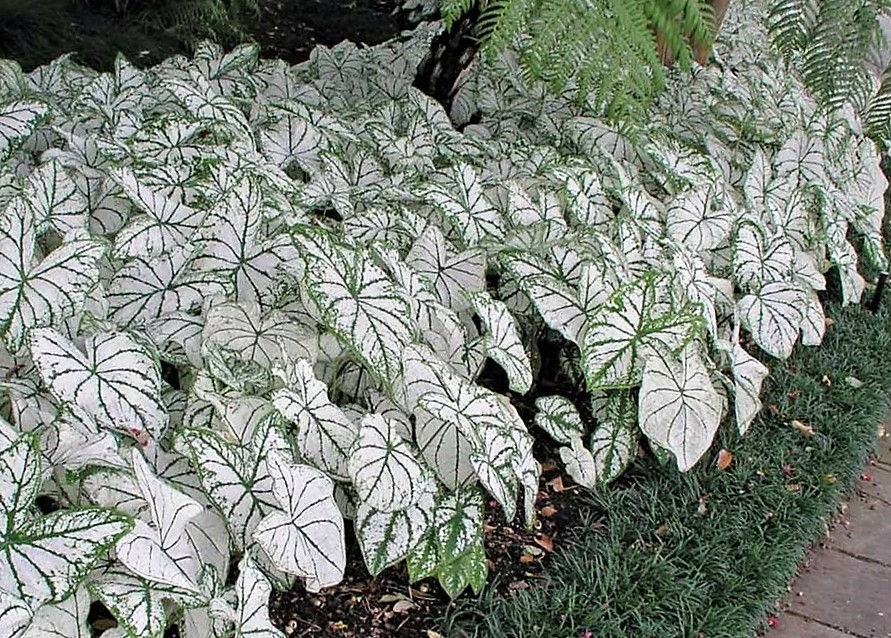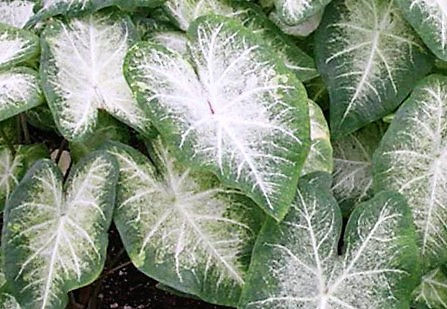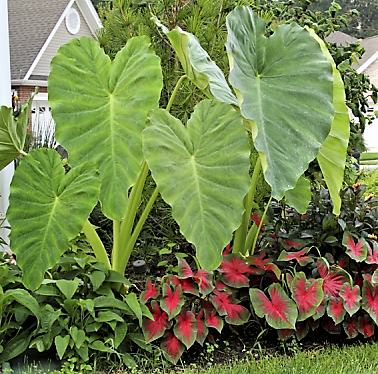The Caladiums of my Childhood, and more
- vendiolaads
- Aug 17, 2022
- 5 min read
Caladiums were my Lola Enyang's favored garden plant because they were no-fuss, easy-to-care, fast-spreading plants that made shady areas in our vegetable and food garden looked attractive. My Lola Enyang, a struggling single mom of my mother and her siblings, was a practical gardener, raising vegetables and root crops and fruiting trees for our dinner table and for her to sell to neighbors and friends for her meager income. But she had the white caladiums lining up our shaded walkway, mainly for aesthetics since I didn't think the caladiums were edible.

My mother continued planting caladiums after her mother passed on. But my mother explored the cultivation of rarer, so hard-to-find varieties of caladiums. My mother favored caladiums with multi-colored leaves, those with curly or serrated leaves, aside from my lola's mainly white caladium with shovel-shaped leaves. My mother was gardening for visual display.
So when I returned to my hometown in Bacong, Negros Oriental after my mother passed on, I missed her caladiums. They were pulled out and thrown to the heaps of dead banana leaves, composting leaves, and the garbage collected after people swept our yard. Our ancestral home in the barrio had so many plants and trees around it, that sweeping the yard of fallen leaves and dead plant parts was a daily chore among my relatives who stayed or visited our old house after my mother was gone.
The white caladiums started by my lola and then later cultivated by my mother proved to be hard-to-kill plants. Many survived among the garbage heap and dumped leaves. The compost in the garbage piles actually provided the caladiums with their needed nutrients.
I had a bamboo plant stand made, and potted all the white caladiums I could gather from the garbage piles. I thought my lola and my mother would be happy to "see" their white caladiums surviving them.
When I visited my ancestral home a couple of years later, however, I noticed the plant stand and all the caladiums were gone. My instinct urged me to check the garbage heaps. But I soon realized I was no longer an owner of the house and yard. I was simply an infrequent visitor. The white caladiums were mere memories, for me, at that time.
After that visit, I longed to grow the white caladiums in my own home and garden now. In my search to find the exact variety of that childhood white caladiums in my present location, I am surprised at how far caladiums have come to grow and flourish in varietals and types of foliage.
Caladiums have come a long, long way from the typical heart-shaped white-splotched, shade-loving plants of my yesteryears.
Caladiums come in many colors now: red bicolor spotted caladium; white Caladium Fiesta, red Caladium Florida Sweetheart
Now, caladium leaves come in more colors than the rainbow, with varying hues and tones. The edges of the leaves are no longer just plain-edged as more caladium plants have been developed to assume serrated, corrugated, frilled, pointed, and various other configurations. Even the old plain-edged leaves now come as smooth, rough, thick, thin, or sharp-edged. The shape of the leaves has become variants of the heart-shaped originals.

Caladiums have been hybridized to possess various colors, leaf shapes and sizes, and patterns of colors and ribbing (ctto: various online photos)
The varieties of caladium have become quite staggering, as people purposely and sometimes inadvertently hybridize this already versatile childhood eye-candy. Plant breeders even reach out online to promote their products. Caladiums are this blog's focus of interest.
Many caladium varieties sport mottled looks, looking like tie-dyed works of art, while most still have mirror-image punctuations, depressions, and colorations. Even heat-tolerant varieties have been developed, so caladium no longer merely reigns as the queen of the shade.
Caladiums have now various leaf patterns and colors: Caladium "Chantinii Lemaire"; caladium palacioanum; caladium "Thai Beauty" (ctto: Photos online)
The colorful beauty also comes in various sizes, from diminutive ground-huggers to statuesque five-footers; from vigorous, almost invasive, spreaders through their tubers (often called bulbs) to very behaved plants that stay in one place for years. My former schoolmates, Agnes Shari Tan Aliman, Chito Delorino, Annie Maglangit Daniel, and many others have shown enviable varietals of caladium.

Caladiums rarely flower, but their beautiful foliage guarantees a colorful show wherever they are planted -- beneath trees, between shrubs, in perennial borders, and in containers, you name it, the emerging plantitas and plantitos have been very innovative and creative with siting their caladium specimen or collection.
Flowers of caladiums may be faintly sweet-smelling but look quite lewd, resembling human reproductive organs, eeew.
Caladium prefers shade or part shade and moisture-retentive soil to thrive and multiply fast. It survives part sun, but the leaves look haggard when intense sunlight blazes on them. Coloration may also diminish in full sun.
It is a low-maintenance beauty. However, some people have reported that the plant is toxic if ingested and may cause contact dermatitis on the skin.
WHERE/HOW TO PLANT CALADIUMS
SPECIMEN PLANT: Use one type of caladium to create an undulating sea of leaves. This method works best when you have a very large garden space, and you want to fill it up with the most visual impact.
COLLECTION: Showcase your collection of caladiums by planting them together, making sure contrasting colors and patterns, height, and bushiness of plants are nicely considered in your plantings.
CONTAINERS, PATIOS, AND DECKS: The foliage of caladiums are attractive enough to decorate your outdoor sitting areas like a lanai. Potted or in planters, white and light-colored caladiums never fail to brighten a shady porch or a covered deck. Punctuate the center with a dark-colored, taller variety for dramatic contrast.
WINDOW BOXES: Strap leaf caladiums are whole-year attractive plants for your window boxes and hanging planters. Hang them in pots around your home to give your place an even more exotic, tropical feel. Of course, the Philippines is already a tropical paradise. I don't think there's the harm in over-exploiting the tropical feel. In fact, surrounding your front with potted and boxed caladiums, with pretty foliage, will increase your home's curb appeal and create a charming "mini-garden" for all to admire.

ENTRYWAYS AND BORDERS: Use fancy leaf caladiums to soften a walkway to your front door, edge a shady garden bed or line a path beneath shade trees and shrubs. My best childhood memory of caladiums was that of our poor, elderly neighbors (Lola Dufina and Lolo Catalino). And my Lola Enyang's, too. They were poor, yet their dilapidated humble on-stilts bamboo-and-nipa house that precariously tilted to one side looked exotic as it had multi-colored caladiums lining its short dirt walkway and an expanse of white-splashed caladiums surrounding the dirty kitchen and the outhouse toilet at the back.
COMPANION PLANTS IN THE GARDEN: Depending on which varieties you choose, caladiums can be bright and flashy or cool and sophisticated. The pinks, greens, and whites pair beautifully with other soft colors, and the red-leaved varieties can hold their own when combined with hot-colored begonias, coleus, and impatiens. Caladiums pair well with dainty-leaved shrubs and with ornamental grasses. At the feet of lubi lubi (ornamental palm trees), caladiums look splendid and calming. Ferns and caladiums look good together as well.

Caladiums are exactly the type of leaf attractions you want in your garden. When it comes to unapologetic and audacious color, the foliage of the caladium alone can stand the competition of any flowers near them. These beautiful plants are a jewel in your garden. Planting caladiums is the best pick for your pesos in this pandemic stay-at-home times.
Hurry though, for if you haven't yet grabbed as many caladium plantlets as you can, pretty soon the Filipinos' ningas cogon attitude will soon drive the prices of these leaf divas to pandemonium level if the pandemic rages much longer. The once lowly white-splotched caladiums have exploded in varieties, color combinations, and popularity. They have proven and elevated themselves to be part of your indoor and your garden's A-lister plants. Caladium plantation it is, folks!
For me, the white caladium is still my favorite, even if only for my childhood memory's sake.













Comments